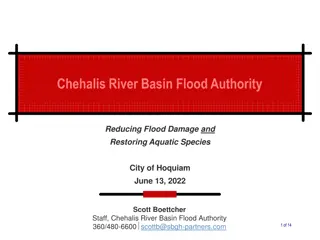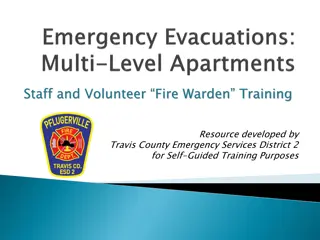Eastern Great Basin Fire Potential Outlook - August/September 2014
The Fire Potential Outlook for the Eastern Great Basin in August and September 2014, as predicted by Meteorologist Shelby Law, indicates recent weather trends, fuel moisture levels, and current fire dangers. The region has experienced above-normal temperatures and varying precipitation levels, impacting drought conditions. The outlook includes forecasts for fire potential in the coming months based on these environmental factors.
Download Presentation

Please find below an Image/Link to download the presentation.
The content on the website is provided AS IS for your information and personal use only. It may not be sold, licensed, or shared on other websites without obtaining consent from the author.If you encounter any issues during the download, it is possible that the publisher has removed the file from their server.
You are allowed to download the files provided on this website for personal or commercial use, subject to the condition that they are used lawfully. All files are the property of their respective owners.
The content on the website is provided AS IS for your information and personal use only. It may not be sold, licensed, or shared on other websites without obtaining consent from the author.
E N D
Presentation Transcript
Eastern Great Basin August September, 2014 Fire Potential Outlook Shelby Law EGBCC Predictive Services Meteorologist
Contents Current Fire Danger Observed Fire Occurrence/Fire Behavior August Weather/Fire Potential Forecast September Weather/Fire Potential Forecast October/November Fire Potential Forecast
Current Fire Danger Recent Weather Trends Fuel Moisture Fuel Loading
Recent Weather Trend Temperatures for the past 30 days have been above normal region wide with the warmest area coming in at 4-6 degrees above normal in western Idaho. Precipitation was generally below normal across Idaho, while Utah received above normal precipitation along the higher elevations due to regular surges of moisture from the south. The weather pattern during much of the month of July was dominated by a high pressure ridge over the western United States. This pattern allowed for frequent surges of monsoonal moisture beginning at the beginning of the month and occurring with enough frequency to keep widespread elevated large fire potential at bay. Drought conditions have worsened slightly over the past month with moderate to severe drought present across much of the region. The drought is forecast to improve through the summer months over Utah as the El Ni o develops. Drought conditions are the worst along the Snake River Plain in Idaho with a bull s-eye of extreme drought over south central Idaho.
Recent Weather Trend Temperature Departure from Average Precipitation Percent of Average 7/01/2014 - 7/30/2014
Drought Monitor and Outlook Drought Monitor Drought Outlook
Energy Release Component Western ID Mtns Eastern Idaho Mtns Northwest UT Southeast UT
Fuel Moisture - Sagebrush Southwest Idaho Western Idaho Mtns Arizona Strip Northeast Utah
Fuel Moisture 1000-hr Western Idaho Mtns Southern Utah Mtns
Fuel Loading Grasses The 2014 grass crop is below normal across much of southwestern Idaho, with only the Orchard site reporting total loading amounts above previous years values.
Observed Fire Occurrence YTD fire occurrence has been above normal, but acres burned is much below normal due to the recent cool and wet weather. 2014 YTD 10 Year Average Fires 1,725 1,123 Acres 84,168 391,311
August Fire Potential Outlook Large fire potential is expected to be normal through the month of August for all but the western edge of Idaho where dry conditions will likely persist and may result in above normal activity. A few surges of moisture are expected to move into Utah and eastern Idaho/western Wyoming during the first two weeks of the month, keeping fire potential low, while western Idaho may be on the fringe of the activity Large fire potential should also end up below normal over western Wyoming and northeast fringe of the geographic area during August. Live fuel moistures have begun to bottom out for the season across much of the region and are quite low in western Idaho. Increased fire activity is possible in Utah during any periods of hot, dry and windy weather, which are more likely during the second half of the month.
September Fire Potential Outlook Fire potential is expected to be normal across all of the Eastern Great Basin during the month of September. September may see warm and dry conditions, which could lead toincreased initial attack, but not likely large fire activity. As the days get shorter and nights see good RH recovery as the month progress new fire starts may be possible, but shouldn t become long duration problem fires.
Sep/Oct Fire Potential Outlook Large fire potential should be normal during October and November, which for the time of year is quite low.
The End Send Questions/Comments To Shelby Law, EGBCC slaw@blm.gov























